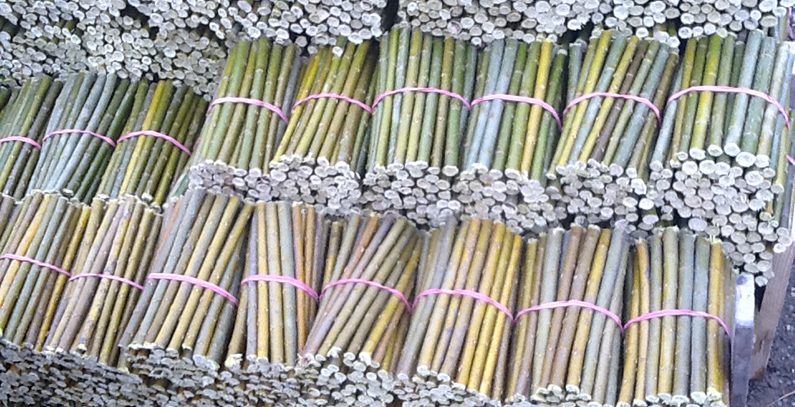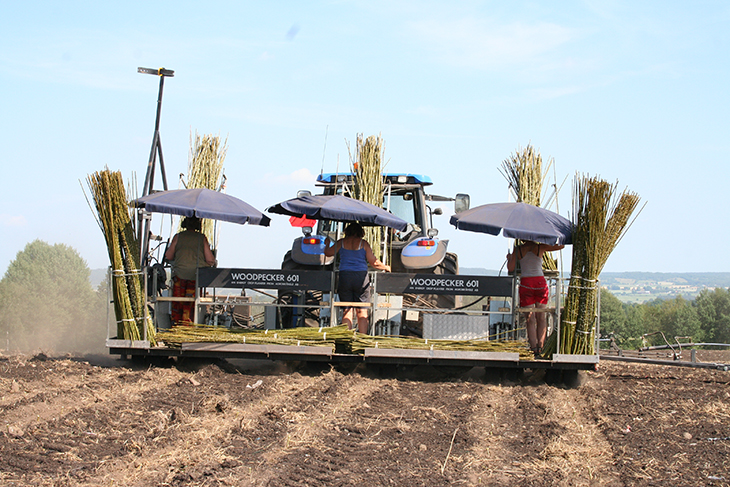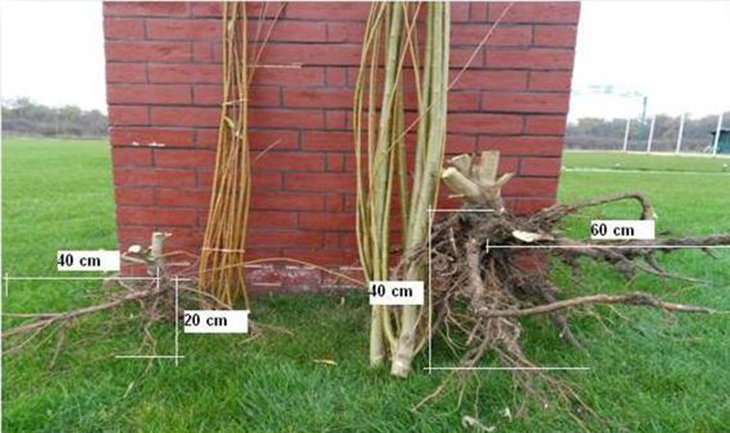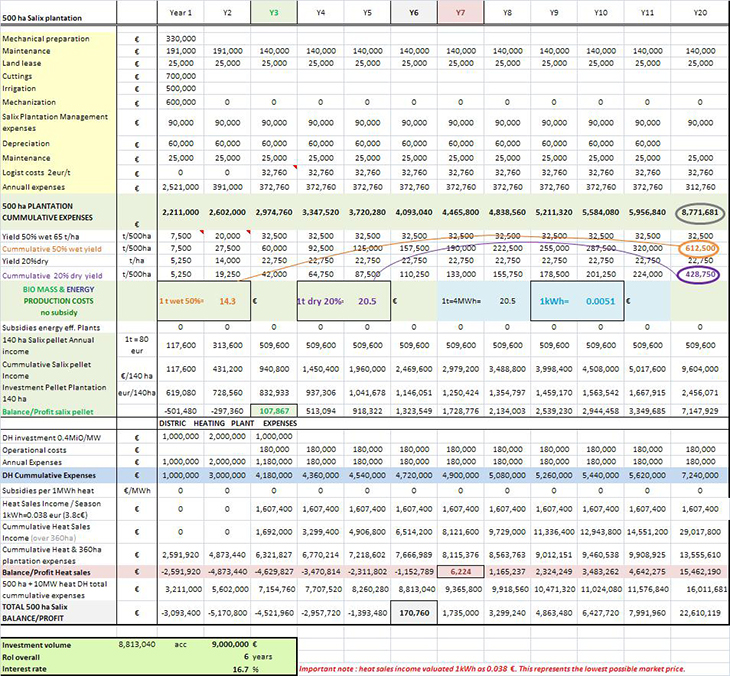
Photo: Rebina Group

INTRODUCTION AND FRAMEWORK FOR SALIX VIMINALIS IN SERBIA
Global quest of ways and technologies for the CO2 reduction and fight for a cleaner and sustainable future has delivered numerous solutions among which a significant role plays substitution of fossil fuels with the renewable ones. In the scope of renewable sources, beside the wind, solar or hydro power and bio fuels, biomass deserves a particular respect due to its vast potentials, particularly in Serbia and Eastern Europe.
National Renewable Action Plan and 2020 Energy Strategy and its provisions oblige Serbia to increase participation of renewable energy in overall balance from 21 to 27% by year 2020. Since 2015 Serbia is facing with budgetary issues which prevent engaging any further credit lines. Due to the fact that municipal bond have not been introduced all loans acquired by local authorities need to be guaranteed by the State which in this (and in longer coming period) moment is not an option. Reconstruction of district heating facilities to biomass powered is thus left to other financing schemes, possibly Public Private Partnerships (PPP) scenarios, for which respective Law and By Laws exist.
High and permanent quality of wooden biomass together with a possibility to have independent, steady and reliable biomass production puts forward the cultivated biomass scenario having in mind vast areas of low quality, degraded or flooded land, particularly in northern Serbia – Vojvodina. Strong advantage lies in the cultivation of short rotation woody species such is the SRC “energy willow” Salix viminalis due to its bi and annual harvest ability, high quality fuel and moderate investment requirements.
Recent changes in legislation, the amended Law on the Agricultural Land and the ongoing land restitution process enabled firm legal grounds and long lease period of the arable land suitable for the “energy agriculture”. Though Salix viminalis can be considered as a tree, its’ cultivation should not be considered as forestry but as agriculture, due to typical maintenance required – irrigation, fertilization and frequent harvesting.
High demand for a high quality bio mass and land potential forced scientists and professionals to make an analytic approach thus stepping out of purely commercial promotions of many energy crops and species existing on the market often false presenting particular characteristics and advantages. Belgrade University Forestry Faculty together with other stakeholders: Agriculture Land Directorate, Forestry Directorate, State Cadastre and Institute for Pedology are preparing the interdisciplinary study on “Effects of Cultivation of the SRC Salix viminalis variety Inger in Serbia” which shall by the 2016 end clearly elaborate all aspects, requirements, expected yields and locations suitable for cultivation of this plant.
SALIX VIMINALIS IN BRIEF
Energy willow, sylvan species with short rotation cycle (SRC) and vegetative regeneration, is a ligneous and shrubby plant, having a rapid growth up to 3 – 3.5 cm/day and a lifespan of 20-25 years. In 2-3 years it can grow at shoots height of 6-7 m with a shoots base diameter of 6-8 cm. Beginning with the 2-3rd year a yield of at least 35 t/ha/year (wet) biomass can be obtained in form of raw biomass – bales, chips, or straight rods and pellets or briquettes.
Salix as a spice is autochthonous over East Europe though with a different genome. Due to intense hybridization (and NOT genetic modification) many varieties are available today at REBINA. All of them bear benefits of extremely fast growth, high yields and low soil requirements.

Picture 1: Two-year-old plantation in Glimboca, Romania
Characteristics
- Rapid growth: up to 3-3,5 cm/day
- High caloric value: 4900 kcal/kg ~ 19-21 MJ/kg ~ 5.5 KW/kg of dry bio mass
- Remarkable adaptability to different pedoclimatic conditions
- Constant biomass harvest for 20-25 years. Applying adequate technology, annual bio mass yield of over 60 t/ha can be obtained
- Suitable for soils with water excess, polluted and degraded soils
Utilization areas
- Biomass production for heat, electric energy and pellet/briquette production
- Protective curtains erection for field crops, as well as for roads and railways
- Soil stabilization: sloping grounds and river banks erosion prevention, industrial ash depositories stabilization, agricultural land wind erosion
- Improvement of degraded soils and their reintroduction into the production cycle
- Natural wastewater treatment and soil phytoremediation
- Drainage of soils with water excess
CLIMATE, SOIL AND WATER REQUIREMENTS
Salix viminalis develops very well under temperate climate conditions, with average annual temperatures of 8-12 ° C. It does not demand that much light, as long as the recommended densities are satisfied. Tolerates frost up to – 30 ° C and moderate drought. It can be grown on different soil types, supporting a pH between 3.5 and 10, the ideal value being between 5.5 to 7.5. Has a zero tolerance to salty soils.
Yields depend on soil quality, climate and water availability. Out of these elements water availability is the by far the most required for the yield maximization. In given sense if there are no natural conditions perfectly suitable, irrigation needs to be implemented in order to reach maximal yields and profit.
LAND PREPARATION
Soil preparation begins in the year before the establishment of the plantation by removing the weeds by administration of non selective (total) herbicides. After removing the vegetation the land is deeply mellowed after which is being plowed and disc/roto harrowed. Once the soil is prepared basic fertilization may be carried out. At early spring land should be ready for hosting Salix cuttings.
PLANTING MATERIAL
For the establishment of the plantation there are selected energetic willow varieties and hybrids, each adapted to specific soil and climate conditions. Planting material – cuttings (Pic. 2), must be of good quality and certified. Recommended varieties for Western Balkan region may be: Inger, and possibly Tora and Tordis.

Picture 2: Salix viminalins cuttings
PLANTING
Usually accepted time for planting is during the spring as early as possible, when there is moisture in the soil. Planting is done in twin rows with distances in between, to allow the access for maintenance, harvesting and transport mechanization. Axial plants distance in the row is 75 cm, distance between two rows is 75 cm while the space between twin neighboring rows is 1,5 m. This way a planting density of ~14.000 cuttings/ha is obtained.

Picture 3: Salix viminalis mechanical planting with three-raw planter
Planting can be done mechanically or manually. Manual planting requires 8-9 man/day/ha. Mechanical Seeding Rate: 3.000 Cuttings/hr (2 rows planter at 3.6 km/h).
YIELDS AND HARVESTING
Yield is eventually all that matters in this business’ sense. High yields may be established in most of the East Europe, even on low quality soils, in case there is enough water through vegetative season. Climate changes have caused rapidly growing arid conditions thus making irrigation a must (at least REBINA consider it so). On the following picture a two-year-old irrigated and non irrigated plant, willows’ response to water shall be self explanatory:

Picture 4: Root of two-year-old of irrigated and non-irrigated plant
On properly maintained plantations with the irrigation system in place annual yields of 60-70 t/ha (wet mass at harvesting) may be reached. Optimal harvesting frequency is every second year, thus making harvesting mass of 130 or more t/ha. To gain more tangible image it would require a bundle of Salix to weight ~9 kg since there are 14.000 plants/ha. Without irrigation over last 5-6 years average yields reached at the most 30-35 t/ha/year on well administered plantations.
The first harvesting is usually performed in the 2 or 3rd year i.e. when the yield exceeds 25-30t/ha. Harvesting frequency is in direct relation to the yield and defers from region to region whereas in Western Balkans harvesting frequency should be performed bi-annually. Harvesting happens when the plants shed their leaves, in the vegetative rest period from November until March.
Specialized machines cut the rods in various shapes: in form of chips, which are collected in trailers and piled in sheds, wrapped in round bales of 400-500 kg stored in open space or as straight shoots – depending on the end user requirements. Moisture content at harvest is about 45-50+%. After a storage period of about 2-3 months bales left on the field due to draught and the sun spontaneously decrease moisture to 10% -20% requiring no sheds. Such stored biomass does not lose any quality in time.

Picture 5: Bio baler harvester and bale trailer
Info: http://www.grpanderson.com/en/ and https://www.youtube.com/watch?v=-kwqnKBcQiE
Bio baler requires a 200+ HP tractor and can harvest 8 ha/shift, or almost 24 ha/day. Soil needs to be frozen or fairly dry.
PLANTATION ERECTION AND BIOMASS PRODUCTION COST
A rough cost brake down €/ha would be:
CAPEX
Planting material (cuttings) 1.400
Soil preparation 1.000
Irrigation system 1.000
TOTAL 3.400
OPEX (annually)
Harvest, maintenance, land lease 300
Detailed elaboration of cost is presented in Table 1 below:

Table 1: Cost of Salix biomass over a 20 year period
Production price of 1t biomass 50% humid = 14.3 ad. 15€
Production price of 1t biomass 20% humid = 20.5 ad. 21€
Biomass (20% humid) heat capacity = 4MWh/t, i.e.
Net energy production price 1 kWh=0.00525€
If a boiler efficiency ŋ=0.8 and a plant efficiency ŋ=0.8, total efficiency would be = 0.64, than
Gross energy production price 1 kWh=0.0082€ ( 0.825c€)
UTILIZATION EXAMPLES
High and growing natural gas prices, need for fossil fuels replacement and high state debt level brings a PPP investment opportunity in the area of district heating systems. Most of the deteriorated land lies in northern Serbia – Vojvodina, where forestation ratio is below 5% making these territories ideal for cultivated biomass production and immediate heat sales due to the existing demand.
10MW HEAT ONLY PLANT
Salix chips demand

Table 2: Wood Heat/Moisture content ration
Required quantity of biomass In heat only regime 180 days/year x 24 hrs = 4.230 h
Produced heat energy: 4.230h x 10 MW = 42.300 MWh
![]()
( Boiler efficiency η=0,8 , heat plant efficiency η=0,8 )
Calculated amount of wooden chips requires 16.523t /0,7= 23.604 t of biomass to be harvested with ~ 50% humidity. Assuming the yield of 65 t/ha, would require a plantation of 363ha (23604/65), or 36ha/MW . For a CHP of 1 MW an area ~ 95 ha would be needed.
WIND AND SNOW BARRIERS
A frequent need is to prevent or decrease the wind speed or snow pilling on roads or railways. Salix wind brakes (Pic. 9, Fig. 1-3) have proven to be cheap, safe and fast remedy for such a problem with a strong additional safety feature in areas bordering roads and highways: not having the trunk but many shoots barriers act similar to the air bag in the vehicle, slowly consuming kinetic energy in case of the accident. Wind barriers are longitudinal forms having the width of several to tents of meters, while curtains (Pic. 10) may have width of just a few meters.
WASTE TO ENERGY – WASTE WATER BIO TREATMENT, PHYTOREMEDIATION AND BIOMASS PRODUCTION
The Collect Treat & Use (CTU) principle was designed as a particular and lasting solution for the waste water problem of smaller and/or rural settlements making them independent form the State/Local Governments, its plans and restrictions and delays in construction of the WWTP. Solution requires construction of one collection point for all excess waste waters from the settlement in which waste waters shall be aggregated, conditioned and used as pre treated water of sustainable quality. Latter is that additional added value deriving from utilization of the waste water as a resource in reaching the profit function without jeopardizing the environment.
I WWBTP should be erected individually for the each settlement consisting of two entireties: first with a screen for the prime separation – rough particles catching operative in all climate conditions, and an underground aeration and sludge aggregation tanks with longitudinal cascades. Followed downstream are wet fields with cultivated phytoremediation capacitive plants being irrigated with the waste water exceeding the separation/segregation tanks in this, tertial purification phase. Plants that have been scientifically and practically proven to be efficient in phytoremediation, having at the same time extremely high transpirations values are cane (bulrush) and varieties of Salix, with Salix viminalis as a leader in lignocelluloses biomass production. Cane, i.e. microorganism living on the root system, are active in all 12 months/year and so is the gravel layer with micro bio active layer around every particle beneath it.
For a WW output of e.g. 2 l/s area with planted cane should be roughly 6m2/habitant, and area with Salix needs to be dimensioned to consume this 2l/s for irrigation even in dormant winter period when it should actually act as an in ground reservoir. As an orientation this area may be expected to reach up to 5ha.
II Waste water collectors network should be low pressure/low diameter PVC collector instead of gravity based conduits of 10 and more times larger diameters, and with up to 5 times shallower installation depths.
What would be benefits of such an approach?
- Compulsory replacement of all individual porous septic tanks with non permeable ones leading immediate termination of soil and ground water pollution in villages
- Immediate termination of illegal discharging of septic tanks with highly contiguous content in nearby canals, creeks or wetlands
- Utilization of cheap e.g. PVC pipes for construction of collector distributive and main collectors.
- Low pipe/trench ground installation depths with no cascades needed thus leading to modest and inexpensive excavation and earth works.
- Phase approach in construction of the entire WW system where a WWBTP may be functional immediately upon construction without collector network being constructed.
- Low CAPEX and OPEX costs for inhabitants due to low power demands of their septic tank individual waste water pumps.
- Low investment volume and operational expenses required for the WWTP.
- Activation of land not being suitable for human agriculture utilization, or the one of the poorest quality, which every village possesses on own territory.
- Clear profit function established through sales of bio mass harvested from wet fields.
- Increased (a)forested areas which contribute also to aggregation of the local wildlife.
- Support to the local DHs orientation towards reconstruction from heavy fuels/lignite and even gas to bio mass powered ones.
ABOUT REBINA GROUP
REBINA Group Romania is a group of Austrian-German-Romanian companies whose activity is aimed at promoting non-conventional and renewable energy sources, primarily from biomass.
S.C. REBINA Agrar S.R.L., part of REBINA Group Romania, with its headquarters in Ghilad, Timis County, has the largest energy willow nursery in Europe. It holds the license to produce and sell planting material for energetic willow – Salix viminalis. S.C. REBINA Agrar S.R.L. supports the growers by ensuring: planting material, biomass buyoff and specialized technical consulting.
REBINA Agrar d.o.o. supports REBINA Group in Serbia, offering technical consultancy at the area of bio energy utilization and production as well as Salix viminalis cuttings.
REBINA Asia Pacific Limited, established beginning the year 2014 is responsible for activities in South East Asia, Japan and China.

















